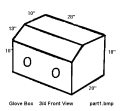 Glove box 3/4 front view
Glove box 3/4 front view
If you have any construction knowledge, or capability, the diagrams provided on the following pages and the brief commentary below is enough to get you going. Otherwise, give this material to a good handyperson and he she can build it for you.
This is constructed from clear acrylic; 3/8" thick for the bottom and sides, 1/2" thick for the lid. The plastic is joined by Acrylic Weld a clear solvent that can be purchased where you purchase the plastic. The glove holes should be made to fit the type of gloves you intend to use (there are several kinds available). The small speckled blocks represent 1/2 x 1/2 strips of acrylic which act to reinforce the joints.
 Laminar Flow box side view cross section
Laminar Flow box side view cross section
 Conceptual Clean Air Station Design
Conceptual Clean Air Station Design
This is a lot easier to build than it appears. Though only a simple diagram and material list it is self-limiting. If it looks too complicated, or you do not understand it; you do not have the skill to build it.
This is really easy to build if you study a few working models and have an understanding of it's use and of each parts purpose.
This is a really simple project. The three main parts are: The cabinet/base, the motor and the wheel. The base is a simple plywood box; vented to keep the motor cool. The motor is a gearmotor, which turns at 1 rpm, and is rated for continuous duty. Dayton model 22098 is a fine choice. The wheel is made of three layers. The bottom most layer is 3/4"plywood, covered with laminate, the other two are 3/8” acrylic. It is attached directly to the spindle of the motor by means of a cast sheave. The three layers are separated by threaded rods and nuts (the rod can be covered by an aluminum gutter nail sleeve). The holes for the tubes are made thusly: cover the face side of the plywood with laminate and sandwich all three layers together. Drill clean through the three pieces with a hole saw (27 mm for 25 mm tubes)- Then cover the back of the plywood with laminate and attach the three parts together with the threaded rods. The tubes will sit perfectly on the wheel.